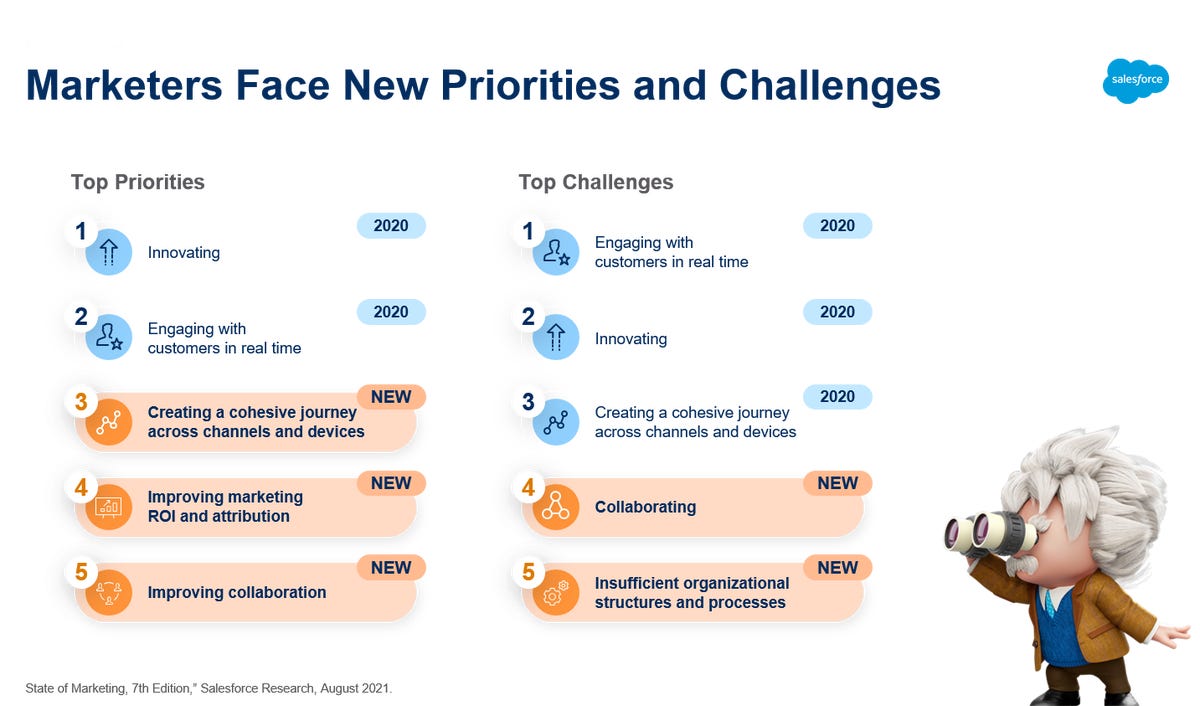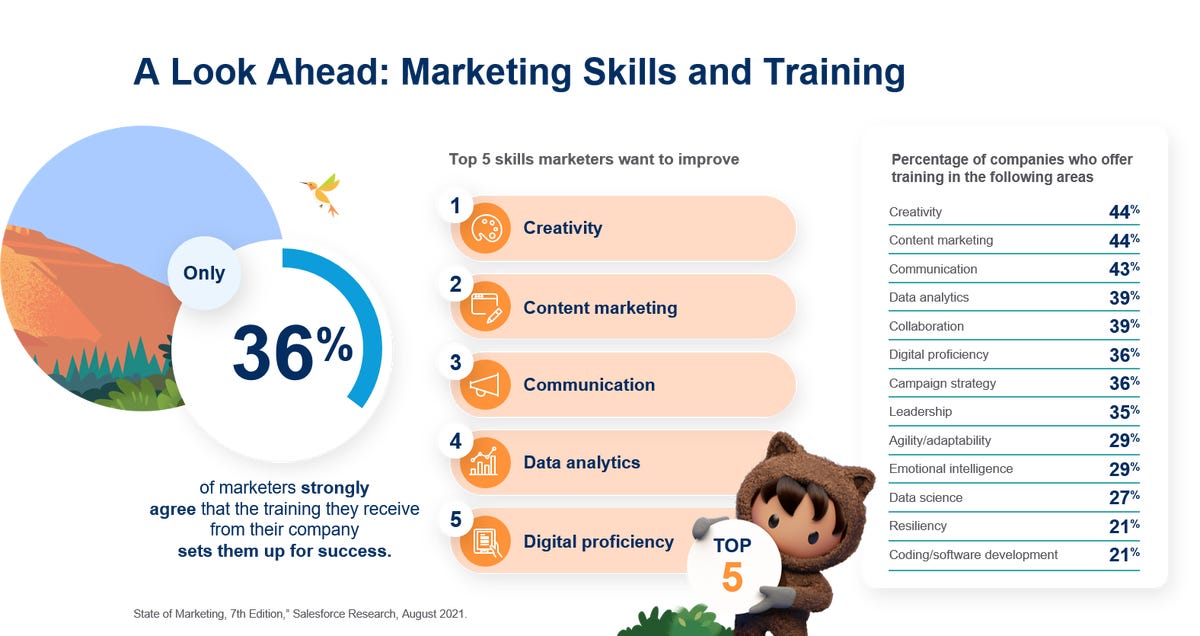Salesforce Research report: State of Marketing 2021 | ZDNet
In the seventh edition of the “State of Marketing” report, Salesforce Research surveyed over 8,200 marketing leaders across 37 countries to discover:
- Which shifts have occurred in marketing strategies, priorities, and challenges during recent economic and social turbulence
- The current state and trajectory of marketing’s digital transformation
- Trends in marketing data management
- How collaboration is changing as many teams operate remotely
State of Marketing 2021 – Salesforce Research
The business world has experienced change at unprecedented scale and speed. The pandemic created decentralized and digital-only, digital-first business engagement models that lasted throughout 2020 and continues to permanently shape our future today. Customer expectations, buying behaviors, engagement preferences and expanded use of channels have redefined existing business models and created new ones. As the world transformed, so did marketing.

As the World Transformed, So Did Marketing
Here is the high-level summary findings of the report which highlights marketing trailblazers focused on embracing technology, data and new measures of success.
- Marketers Embrace Change and Optimism: Emerging from a time of great upheaval, marketers are focused on a future of innovation and real-time engagement. Sixty-six percent of marketers expect revenue growth over the next 12-18 months.
- As Customers Go Digital, Marketing Steps Up: After years’ worth of changes in customer behavior occurring over the course of months, marketers are accelerating their digital transformations. Ninety percent of marketers say their digital engagement strategy has changed since the pandemic began.
- Collaboration Drives the Market From Anywhere Era: No longer tied to offices, a distributed workforce is reevaluating how they engage not only customers, but each other. Seventy-five percent of marketers say the pandemic has permanently shifted how they collaborate and communicate at work.
- Marketing Is Spelled D-A-T-A: Data empowers marketers to deliver the trusted, personalized engagement customers expect, but managing it is becoming only more complex. Marketers expect a 40% increase in the number of data sources they use between 2021 and 2022.
- Metrics and KPIs Continue to Evolve: As their work becomes more strategic and valuable for the business at large, marketers are reevaluating what successful marketing looks like. Seventy percent of CMOs align their KPIs with the CEO’s.

State of Marketing 2021 Executive Summary
Marketers face new priorities and challenges
Marketers embrace change with optimism and purpose. In fact, 66% of marketers expect revenue growth at their companies over the next 12 to 18 months. Seventy-seven percent of marketers feel their work provides greater value now than it did a year ago. Eighty-eight percent of CMOs say their marketing must transform in order to be competitive. In addition, 61% of high performers say employees are impacting marketing strategy, versus 47% of underperformers

Marketers face new priorities and challenges
What is impacting marketing strategy? The top 5 strategy influencers are: 1. customers (63%), 2. technology (59%), business model transformation (57%), 4. competitive pressure (55%), 5. employees (51%).
As customers go digital, marketing steps up
The North Star for high performing marketers is customer experience. Four in five customers agree the experience a company provides is as important as its products or services. Eighty percent of marketers say customer experience is the key competitive differentiator. And 72% of marketers say meeting customer expectations is more difficult than a year ago.

As customers go digital, marketing steps up
Changing customer expectations means a swift and substantial migration to digital channels that will persist for the long term. Sixty-one percent of customers expect to spend more time online after the pandemic than they did before. Eighty-eight percent of customers expect companies to accelerate digital initiatives due to COVID-19. Sixty-nine percent of customers say companies should offer new ways to get products and services due to COVID-19.
Marketers have embraced digital channels in masses. Here are the most popular digital channels amongst marketers: 1. social media (91%), 2. digital ads (91%), 3. video (90%), 4. digital content (88%), 5. website/app (86%), 6. events and sponsorships (84%), 7. email (76%), 8. mobile (69%), 9. direct mail and print ads (69%), 10. audio (66%). Video is the start channel of 2021. With customers largely hunkered down at home with their devices, it makes sense that digital channels have become even more prized than before. Ninety percent of marketers say their digital engagement strategy has changed since before the pandemic, and 89% say their marketing channel mix has changed.
Seventy-eight percent of marketers say they engage customers in real time across one or more marketing channels. Over two-thirds of marketers now describe their cross-channel coordination as dynamic — meaning that messages evolve in a hyper-personalized manner based on customer actions. That compares to fewer than one-third of marketers who reported dynamic cross-channel coordination in 2018. 84% of marketers say they adapt marketing strategy and tactics based on customer interactions.
Eighty-three percent of marketers say their ability to meet customer expectations depends on their digital capabilities, and 83% say their work will be more technology-driven after the pandemic than before. Here are the top 10 most popular digital technologies for marketing:
- Customer Relationship Management (CRM) Platform (89%)
- Marketing Analytics (88%)
- Marketing Attribution Tools (83%)
- Advertising Platform (81%)
- Marketing Automation/Journey Management (81%)
- ABM Platforms (79%)
- Interaction/Personalization Management Tools (77%)
- Email Service Provider (75%)
- Content Management Platforms (CMS) (71%)
- Customer Data Platform (CDP) (70%)
Marketers’ embrace of artificial intelligence (AI) follows that of customers. Sixty percent of customers are open to the use of AI to improve their experiences. Sixty percent of marketers have a fully defined AI strategy — up from 57% in 2020 — although the gap between high performers (64%) and their underperforming competition (45%) persists. Marketing AI use cases are evolving. Here are the top 4 AI use cases for 2021:
- Drive next best actions
- Personalize and overall customer journey
- Personalize individual channel experiences
- Process automation
Collaboration Drives the Market-from-Anywhere Era
Marketing employees can work from anywhere. 82% of marketing organizations are adopting new policies around remote work. Seventy-five percent of marketers say the pandemic has permanently shifted how they collaborate and communicate at work.
Sixty-nine percent of marketers say it’s harder to collaborate now than before the pandemic. But marketers are adapting. Seventy-eight percent of marketing organizations have adopted new work collaboration technology due to the pandemic. 85% of marketers say they use video conferencing, and 82% say they use channel-based collaboration.

Marketing from anywhere and the hybrid future of work
Working from anywhere, delivering successful outcomes everywhere. That is the power of adopting a digital-first mindset and expanding the business boundaries to wherever it makes sense to do so. This means marketing must collaborate with all lines of business to ensure the delivery of the best possible customer experience. And customers today expect this from all brands. 76% of customers expect consistent interactions across departments, but 54% say it generally seems like departments don’t share information. The ability to co-create value at the speed of need, marketing and other lines of business must build and maintain a data sharing culture. This is all about improving decision velocity and relevance by delivering just-in-time value to all stakeholders.
Marketing Is Spelled D-A-T-A
Like humans need water, marketing needs data — and lots of it — to be effective. 78% of marketers say their customer engagement is data-driven. Average number of data sources used by marketers in 2021 is 10.

Marketing is spelled D-A-T-A
Known digital identities such as email addresses and social IDs are now the most popular customer data sources, followed by transactional data and declared interests and preferences. Here are the 2021 ranked customer data sources in popularity:
- Known digital identities
- Transactional data
- Declared interests/preferences
- Second-party data
- Inferred interests/preferences
- Offline identities
- Anonymized digital identities
- Third-party data
- Non-transactional data
According to the research, with so many types and sources of data at their fingertips, marketers are turning to technology to help them make sense of it all. Seventy-eight percent of high performers say they use a customer data platform (CDP), versus 58% of underperformers. The report highlighted the importance of customer data privacy. Seventy-eight percent of marketers say they have a comprehensive view of all customer consent elections.
Metrics and KPIs Continue to Evolve
Seventy-eight percent of marketing organizations have changed or reprioritized metrics due to the pandemic.
Revenue and funnel performance remain the foremost metrics for today’s marketers. However, marketers have become more KPI-conscious across the board, with customer referral rates, customer acquisition costs, and content engagement seeing the biggest boosts in popularity. Regardless of the specific metric, the increasingly strategic nature of marketing means that KPIs must be in line with those of company leadership. Seventy percent of CMOs align their KPIs with their CEO’s.

Marketing metrics and KPIs continue to evolve
Customer satisfaction metrics such as Net Promoter Scores remain marketers’ most helpful measure of success — outranking even revenue and marketing and sales funnel metrics. Only 66% of marketers say they can measure campaign performance in real time. Only 64% of marketers say their measurement and attribution is automated.
LOOK AHEAD: Digital Marketing Tactics
Only 44% of marketers rate the employee training they receive as excellent. While creativity, content, and communication are the most common elements of marketing organizations’ curriculums, they are provided by only a minority of employers.
“Even less common is training on interpersonal skills like emotional intelligence, the data science that underpins digital customer engagement and attribution, and perhaps the most important skill of all in 2021: resiliency,” State of Marketing 2021.

The future of marketing must focus on skills and training
The State of Marketing 2021 Report, by Salesforce Research, is an incredible tool for marketing leaders. This extensive report provides insights that can help CMOs baseline their current organization’s capabilities against high performing digital marketers. To learn more about the State of Marketing 2021 report, visit here.
For all the latest Technology News Click Here
For the latest news and updates, follow us on Google News.
